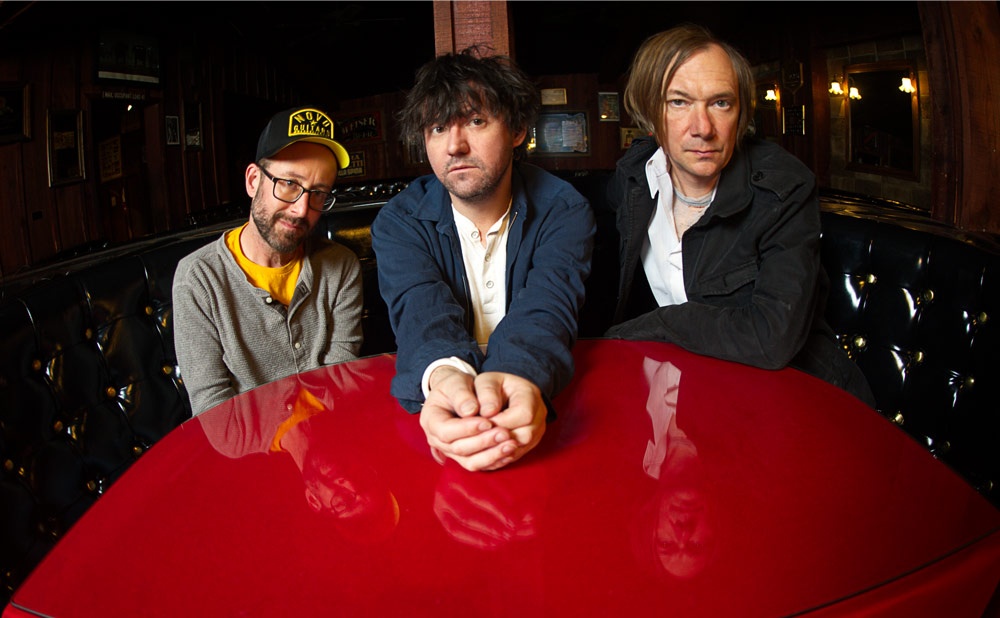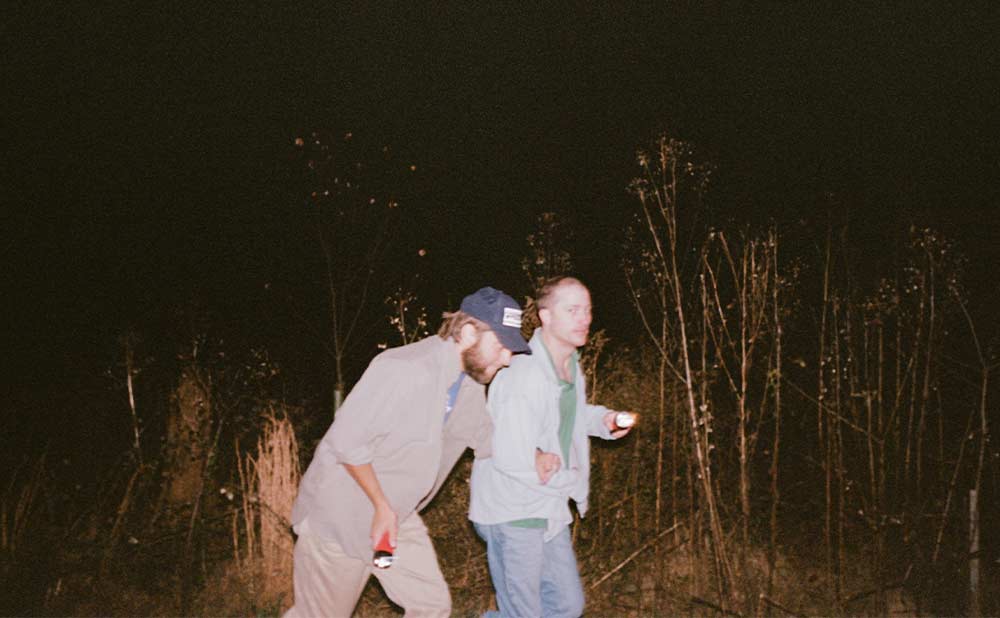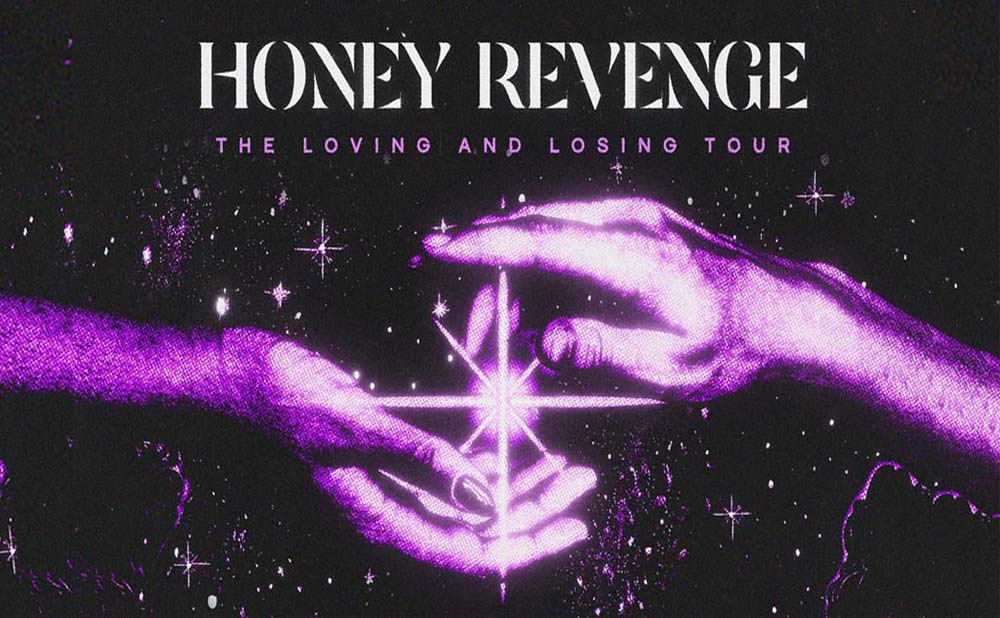Bright Eyes
with Hurray for the Riff Raff

Set Times:
Bright Eyes – 9:15pm
Hurray For The Riff Raff – 8:00pm
Doors – 7:00pm
*Set times are approximate and subject to change without notice.
About Bright Eyes
Five Dice, All Threes is a record of uncommon intensity and tenderness, communal exorcism and personal excavation. These are, of course, qualities that fans have come to expect from Bright Eyes, nearly three decades into their career. The tight-knit band of Conor Oberst, Mike Mogis, and Nate Walcott tends to operate in distinct sweeping movements: each unique in its sound and story but unified by a sense of ambition and ever-growing emotional stakes. Even with this rich history behind them, these new songs exude a visceral thrill like nothing they have attempted before. Oberst has always sung in a voice that conveys a sense of life-or-death gravity. At times throughout Five Dice, All Threes, you may feel worried for him; other times, he may seem like the only one with the clarity to get us out of this mess.
On the self-produced Five Dice, All Threes, Bright Eyes embrace the elusive quality that has made them so enduring and influential across generations and genres, bringing their homespun sound from an Omaha bedroom to devoted audiences around the world. In Oberst’s...
Five Dice, All Threes is a record of uncommon intensity and tenderness, communal exorcism and personal excavation. These are, of course, qualities that fans have come to expect from Bright Eyes, nearly three decades into their career. The tight-knit band of Conor Oberst, Mike Mogis, and Nate Walcott tends to operate in distinct sweeping movements: each unique in its sound and story but unified by a sense of ambition and ever-growing emotional stakes. Even with this rich history behind them, these new songs exude a visceral thrill like nothing they have attempted before. Oberst has always sung in a voice that conveys a sense of life-or-death gravity. At times throughout Five Dice, All Threes, you may feel worried for him; other times, he may seem like the only one with the clarity to get us out of this mess.
On the self-produced Five Dice, All Threes, Bright Eyes embrace the elusive quality that has made them so enduring and influential across generations and genres, bringing their homespun sound from an Omaha bedroom to devoted audiences around the world. In Oberst’s songwriting lies a promise that our loneliest thoughts and feelings can take on grander shapes when passed between friends, blasted through speakers, or shouted among crowds. This time around, the band invites such like-minded voices onto the record with them, with notable guest appearances from Cat Power (“All Threes”), The National’s Matt Berninger (“The Time I Have Left”), and Alex Orange Drink, the frontman of the New York punk band The So So Glos, who co-wrote several songs and shares a climactic verse in the surging “Rainbow Overpass.”
Despite this range of collaborators, Five Dice, All Threes is as confessional and unguarded as Oberst has sounded in years. Throughout these timelessly constructed yet unabashedly modern songs, he earns his place among a rare class of songwriters who have grown more fearless and boundless with age. In the scenic “Bas Jan Ader”—which takes its title from the 20th century Dutch performance artist whose final act found him sailing into the Atlantic Ocean, never to return—his writing traces the course of a bad memory smoothing out to invite the onset of nostalgia. “I never thought I’d see 45,” he sings to a lapping, chiming melody. “How is it that I’m still alive?” For an artist who has explored unflinching questions of mortality since his teen years, the writing on Five Dive, All Threes conveys a new sense of urgency—and empathy, too.
“For whatever reason, I was born with a brain that’s preoccupied with that kind of thing,” Oberst says of his lifelong penchant for dark subject matter. “When I was young, there was a performative aspect to it, which got reflected back at me. Now I’m at a point where I don’t care what the reaction is going to be. Before it was a little out of my hands—I didn’t know how to write if it wasn’t specific to my actual life. Now I do it by choice.”
Throughout these reflections on the American landscape, Oberst shuttles us from Los Angeles to New York: two cities he has called home and the locations for his recent series of rapturously received, career-spanning solo residencies. Along the course of his journey, he takes shots at tech billionaires and the rise of artificial intelligence; he offers heartfelt wisdom and slips into clipped, surrealist imagery that earns its place among namechecked literary heroes like Vladimir Nabokov and Mark Twain.
For every striking turn in his lyrics, the band knows just how to complement him. On one level, Five Dice, All Threes may be the most fun album in the Bright Eyes catalog, filled with singalong hooks and buzzing performances. “I think it revisits the spirit of our older records,” Walcott says. “There is a real quality of chaos and ecstatic urgency in the performances.” And yet, sitting alongside these adrenalized rockers that sound beamed in directly from the garage, you will find contemplative, psychedelic material like the heartbreaking “Tiny Suicides” and “All Threes,” a song whose jazzy piano solo and free-associative lyrics feel totally unprecedented in the Bright Eyes catalog.
This vivid, cathartic music arrives four years after the band’s 2020 comeback album Down in the Weeds, Where the World Once Was. That record’s zoomed-out lyrics and meticulous studio atmosphere resonated during the peak of COVID lockdown and led to Bright Eyes’ long-awaited return to the road in summer 2021. By this point, they were also deep into their Companions project, in which the band reissued their back catalog via new label Dead Oceans along with newly recorded reinterpretations of material throughout their songbook.
In the aftermath of these exhaustive endeavors, the band felt grateful to be back together and somewhat uncertain about their future. It wasn’t until Oberst invited Alex Orange Drink to stay with him in Los Angeles in winter 2023 when a group of new songs started forming. At first, these back-and-forth sessions on Oberst’s porch were just for fun. Recalling his early days of collaboration and scrappy home-recording, the pair sought to keep each other entertained and inspired, with little thought as to where the material would take them. But after completing gems like the anthemic, self-lacerating “Bells & Whistles” and the punky duet of “Rainbow Overpass,” it became clear that Oberst was tapping into new territory.
When they hit the studio with Oberst’s longtime bandmates—the multi-instrumentalist and producer Mike Mogis, the keyboardist and arranger Nate Walcott—they opted for a fast-paced approach that drew inspiration from formative influences like The Replacements and Frank Black. They sought textures that burst from the mix like gnarly splashes of paint on a blank canvas; they opted for first takes and spontaneous decisions. Referring to 2005’s starkly produced landmark, I’m Wide Awake, It’s Morning, Mogis laughs, “It took us 20 years to make another record that sounds like a band playing live.” But where those songs exposed the raw beauty of the group’s folksier side, Five Dice, All Threes thrashes and squirms and resists classification. In the brilliant expanse of “El Capitan,” they blend a galloping rhythm you might find in a Johnny Cash standard with a swell of funereal horns, shouted vocals, and lyrics that read like a sobering farewell between twin souls. “So they’re burning you an effigy,” Oberst sings. “Well, that happens to me all the time!”
As per usual, the music comes loaded with subtext that invites deep listening—the signature touch of a band who has always honored the album as its own exalted work of art. In the background of these songs, you can piece together a story about love and fate and identity, stitched together from samples of the 1954 Frank Sinatra film Suddenly, a layered orchestra of people sobbing, and a game of dice that borders on cosmic and lends the album its framing device and winking title: In the game of threes, the titular move would indicate a perfect roll. Perfection, however, means something different in the world of Bright Eyes, where our flaws are what grants us authority and finding meaning is only possible if we bear witness to the dark, winding journey to get there. On Five Dice, All Threes, Bright Eyes embrace these beliefs with music that feels thrillingly alive, as if we were all in the room with them, shouting along and gaining the strength to move forward together. It doesn’t just sound like classic Bright Eyes. It sounds like their future, too.
About Hurray for the Riff Raff
Alynda Segarra is 36, or a little less than halfway through the average American lifespan. In that comparatively brief time, though, the Hurray for the Riff Raff founder has been something of a modern Huck Finn, an itinerant traveler whose adventures prompt art that reminds us there are always other ways to live.
Born in the Bronx and of Puerto Rican heritage, Segarra was raised there by a blue-collar aunt and uncle, as their father navigated Vietnam trauma and their mother neglected them to work for the likes of Rudy Giuliani. They were radicalized before they were a teenager, baptized in the anti-war movement and galvanized in New York’s punk haunts and queer spaces. At 17, Segarra split, becoming the kid in a communal squat before shuttling to California, where they began crisscrossing the country by hopping trains. They eventually found home—spiritual, emotional, physical—in New Orleans, forming a hobo band and realizing that music was not only a way to share what they’d learned and seen but to learn and see more. Hurray for the Riff Raff steadily rose from house shows to a major label, where Segarra became a pan-everything fixture of the modern folk movement. But that yoke...
Alynda Segarra is 36, or a little less than halfway through the average American lifespan. In that comparatively brief time, though, the Hurray for the Riff Raff founder has been something of a modern Huck Finn, an itinerant traveler whose adventures prompt art that reminds us there are always other ways to live.
Born in the Bronx and of Puerto Rican heritage, Segarra was raised there by a blue-collar aunt and uncle, as their father navigated Vietnam trauma and their mother neglected them to work for the likes of Rudy Giuliani. They were radicalized before they were a teenager, baptized in the anti-war movement and galvanized in New York’s punk haunts and queer spaces. At 17, Segarra split, becoming the kid in a communal squat before shuttling to California, where they began crisscrossing the country by hopping trains. They eventually found home—spiritual, emotional, physical—in New Orleans, forming a hobo band and realizing that music was not only a way to share what they’d learned and seen but to learn and see more. Hurray for the Riff Raff steadily rose from house shows to a major label, where Segarra became a pan-everything fixture of the modern folk movement. But that yoke became a burden, prompting Segarra to make the probing and poignant electronic opus, 2022’s Life on Earth, their Nonesuch debut. Catch your breath, OK? We’re back to 36, back to now.
During the last dozen years, these manifold tales of Segarra’s voyages have shaped an oral folklore of sorts, with the teenage vagabonding or subsequent trainhopping becoming what some may hear about Hurray for the Riff Raff before hearing the music itself. Segarra has dropped tidbits in songs, too, but they always worried that their experiences were too radical, that memories of dumpster diving or riding through New Orleans with a dildo dangling on an antenna were too much. But on The Past Is Still Alive, Segarra finally tells the story themselves, speckling stirring reflections on love, loss, and the end or evolution of the United States with foundational scenes from their own life. “It felt like a trust fall, or a letting go of this idea of proving something to the music industry—how I can be more digestible, modifiable, sellable,” Segarra says. “I feel like I’m closer to what I actually have to share.”
There is, for instance, sex and communal musicmaking on an island of San Francisco trash during “Snake Plant (The Past Is Still Alive),” a charged attempt to reckon the erosion of our childhood innocence with a belief that a worthwhile future is still possible. Or there are the cops and the trains and the long walks down empty Nebraska highways to escape said cops during “Ogalla,” the cathartic closer that tries to maintain the spirit of the past while actually surviving in the now. The Past Is Still Alive is the record of Segarra’s life so far, not only because it chronicles the past to understand the present but also because it is the most singular and magnetic thing Hurray for the Riff Raff have yet made. A master work of modern folk-rock, The Past Is Still Alive resets the terms of that tired term.
In March 2023, when Segarra returned to the North Carolina studio of producer Brad Cook to cut The Past Is Still Alive, they weren’t so sure about the session, if they could even handle it. Only a month before, their father, Jose Enrico (Quico) Segarra, had died. A musician himself, he had long been fundamental to Segarra’s songs, a point of inspiration and encouragement. What’s more, Segarra had made Life on Earth with Cook, and drummer Yan Westerlund had long toured in Hurray for the Riff Raff. But much of the band they’d assembled for these sessions—guitarist Meg Duffy, fiddler Libby Rodenbough, saxophonist Matt Douglas, multi-instrumentalist Phil Cook—were unknown quantities. At the edge of catastrophe and in the headlock of grief, could Segarra share these bone-deep songs among strangers? “The songwriting is what drove me. I didn’t feel the need to try to transform,” Segarra reckons. “It felt like the truth of where I was at in my life—very vulnerable, very fair, very raw.”
Segarra simply let those complex feelings lead the way, hurling themselves into these excavations of memory and blueprints for what’s to come. Witness, for instance, the tensile resolve in opener “Alibi,” a yearning reflection on addicted childhood friends that pleads with them to join the land of the living while they still can. As the pedal steel moans beneath the snappy country shuffle, their voice frays, a testament to the way they’re bearing difficult witness. That call to survival returns in “Snake Plant,” a song so stuffed with specific childhood memories—scenes from family road trips to Florida, snapshots from discovering oneself on the edge of the world—that Segarra feels like an actual tour guide. “Test your drugs/remember Narcan,” they sing toward the end. “There’s a war on the people/What don’t you understand?” The demand is graceful and winning, not pedantic, lived-in advice from someone who has managed to live when so many friends have not.
This quest to live in spite of outside attempts to kill us off animates “Colossus of Roads,” at once the most devastating and uplifting entry in the entire Hurray for the Riff Raff catalogue. Written like an urgent dispatch after the Club Q shooting in Colorado, it is a paean to the outsiders, a love song for the vulnerable—the queer, the homeless, the radical. Their voice taut as a piece of barbed wire, Segarra deploys poet Eileen Myles and boxcar artist BuZ blurr (the Colossus of Roads himself) to suggest a sanctuary of solidarity for the dispossessed. The United States as we know it can and probably should dissolve, they seethe; as it all comes down, though, Segarra asks to “wrap you up in the bomb shelter of my feather bed.” Brilliantly written and rendered, it is an anthem for a dawning age of collective liberation. “I’ve only had this experience a couple of times, where a song falls on me—it’s all there, and I don’t do anything,” Segarra admits. “It felt like creating a space where all us outsiders can be safe together. That doesn’t exist, but it exists in our minds, and it exists in this song.”
Throughout The Past Is Still Alive, Segarra suggests the profound ability to navigate all this pain, chaos, and trauma, or at least to meet it with senses of wonder and want. To wit, the delightful “Buffalo” uses the iconic American mammal that Americans almost drove to extinction as a metaphor for a new love; can it survive the pressures of society? A duet with Conor Oberst, “The World Is Dangerous” is a heartbroken waltz that still offers to hold someone close, if and when they’re ready.
And even as Segarra tells the tale of the first trans women they ever met, Miss Jonathan in New Orleans, and the beatings they took during “Hawkmoon,” they seem to beam, advocating for a better world yet to come. “I’m becoming the kind of girl that they warned me about,” Segarra sings at the end with devilish aplomb, proud to be carrying on Miss Jonathan’s work of upending norms, whether by sharing Miss Jonathan’s story or simply taking up space for themselves and their own multitudes.
It is especially fraught these days to speak of art in terms of national identity, to flirt with a jingoism that has led to new autocrats and rekindled old wars. But in the best ways possible, The Past Is Still Alive is a distinctly American record, built on twin pillars of peril and promise that have forever been foundational to this country.
The wanderlust that leads to piñon fires near the pueblos of New Mexico’s high desert and all-night escapades in New Orleans. The independence that shapes communities of like-minded outcasts, looking after one another. The inequality that makes such enclaves essential, that makes one of us eat out of garbage and the other with a silver spoon: It is all tragically and beautifully bound inside The Past Is Still Alive. Just as Louise Erdrich has done of late with Native Americans, Lonnie Holley with African-Americans, and Julie Otsuka with Asian-Americans, Segarra expands the scope of American stories here, stretching a long-safeguarded circle to encompass outsiders forever on the fringes. “The past is still alive/The root of me lives in the ballast by the mainline,” Segarra sings at one point, sweeping their days of riding rails directly into whatever success they have found now. Hurray for the riff raff, indeed.
Connect with Hurray for the Riff Raff
Saturday, March 22, 2025
Doors7:00 pm
Show8:00 pm
Venue The Pageant
Age RestrictionsAll Ages
Reserved Balcony $65.00 | $55.00
GA $45.00adv | $50.00dos




